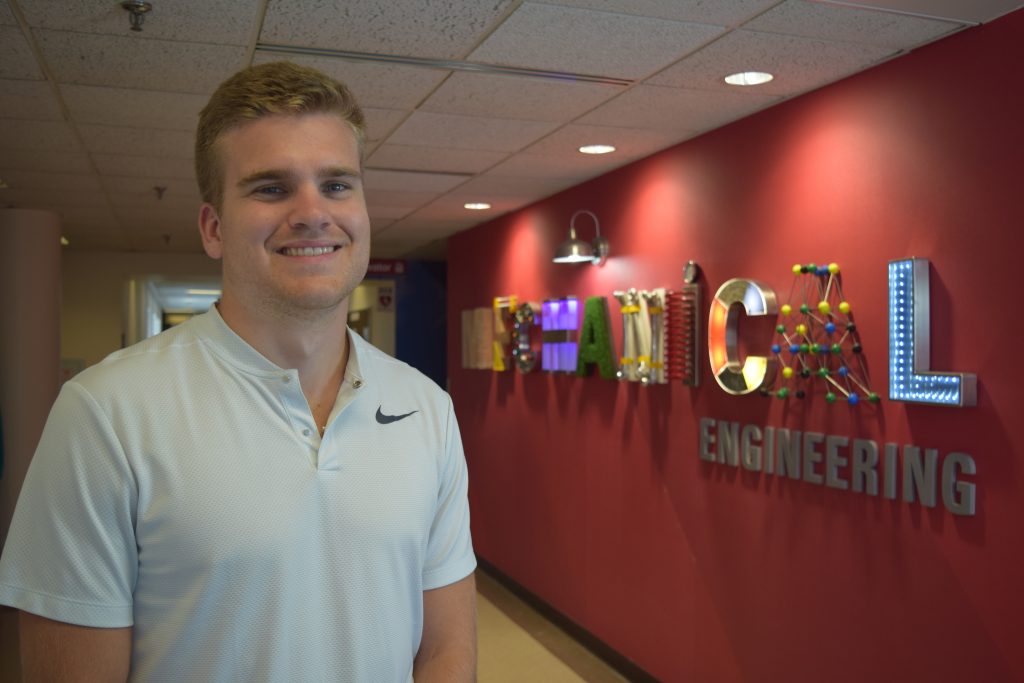 Alex Wrede, a postdoctoral researcher with Hashemi Laboratory, is using engineering to unravel the mystery of traumatic brain injuries – and winning awards for how he tells the story of the impact of his work.
Alex Wrede, a postdoctoral researcher with Hashemi Laboratory, is using engineering to unravel the mystery of traumatic brain injuries – and winning awards for how he tells the story of the impact of his work.
Wrede was the 3-Minute Thesis (3MT) Competition winner at Iowa State University in 2017. He was also the 2016 Dean’s Fellow and received the 2018 Best Paper Award from USASBE, the USASBE Entrepreneurship Education Research Paper Award.
Understanding traumatic brain injuries
Wrede’s research at Iowa State revolves around studying the response that brain cells have when introduced to surrounding traumatic brain injury (TBI) environments. TBIs can affect a person’s memory, senses and other cognitive functions, often caused by a bump or blow to the head.
Wrede’s work is particularly focused on studying intracranial cavitation, which is a formation of empty space or air bubbles within the brain, that may exist in the brain during a TBI. The damage that it yields on surrounding anatomy is currently widely unknown.
Strides in research in these areas have the potential to help those affected by TBIs, commonly athletes or service men and women. Understanding the genetic changes of brain cells also has long-term potential to improve the therapeutics that assist TBI recovery as well as preventative safety measures, such as vehicle airbags.
The Center for Multiphase Flow Research and Education (CoMFRE) focuses on collaboration across multiple disciplines within the multiflow sciences. This interdisciplinary influence was vital to Wrede’s research because the TBI project has involved heavy knowledge in microfluidics, optics, electronics, biology, ultrasonics and multiple other fields. Creating a relationship between these realms through collaboration with CoMFRE was necessary for successful analysis in Wrede’s research.
Wrede’s first publication, “Controlled positioning of microbubbles and induced cavitation using a dual-frequency transducer and microfiber adhesion techniques,” was published in the journal Ultrasonics Sonochemistry. This work focused on setting up an apparatus that simulated cavitation and made the cavitation feasible to implement on biological samples in future studies.
His second publication was titled “Investigation of cavitation-induced damage on PDMS films,” published in the journal Analytical Methods. This study focused on characterizing the physical damage that cavitation had on surrounding elastomer—a polymer with both viscous and elastic properties—surfaces, yielding insight on damage that brain tissue likely undergoes after exposure to surrounding cavitation.
Wrede currently has two additional papers that are in review, and these papers specifically focus on the genetic changes that brain cells undergo after experiencing surrounding cavitation. These papers are collaborative efforts with the Department of Biomedical Sciences.
Working in the Hashemi Lab
The Hashemi Lab, led by associate professor of mechanical engineering Nicole Hashemi, focuses on projects relating to microfluidic systems and strives to understand how microfluidics can be used for materials processing and biological characterization.
Wrede’s research was funded by grants that Hashemi has received from the Office of Naval Research. Wrede emphasized that the progress of this research was only possible through the mentorship of Dr. Hashemi, guidance from fellow members of the Hashemi Lab, and collaborative efforts from other scientists across campus.
“Working in the Hashemi Lab has been a blessing for multiple reasons,” said Wrede. “Dr. Hashemi’s vision and knowledge were really helpful in setting ambitious yet attainable goals throughout these studies. Overall, working in the Hashemi Lab has been a great experience, which was vital in the overall progress and success of this project.”
Three-Minute Thesis Competition
Wrede won the 3-Minute Thesis (3MT) Competition in 2017 with his presentation “Studying Microbubbles to Treat Traumatic Brain Injuries (TBI),” highlighting his exploration into TBIs and how it will affect and benefit the public.
Each year, the 3MT Competition is open to all majors in the graduate college, during which students are given three minutes and one static slide to clearly and concisely convey their research to a non-specialist audience. The Grand Winner has the opportunity to travel to Wisconsin to participate in the Regional 3MT Competition and attend the annual conference of the Midwest Association of Graduate Schools (MAGS).
“Always have a perspective on the applications and understanding of why your research matters,” said Wrede. “It is also important to be able to articulate the importance of your research to people from the general public.”
Wrede grew up in Minnesota and attended Bethel University in St. Paul for his undergraduate studies in applied physics, and he later attended Iowa State University for his master’s and Ph.D. in mechanical engineering. He pursued engineering as a young professional because he wanted to devote his passion and skills in math and science to apply creativity and implement innovation to help better society.